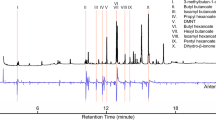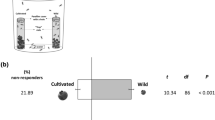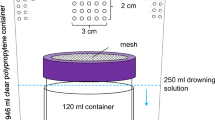Abstract
A mixture of behaviorally active volatiles was identified from the fruit of snowberry, Symphoricarpos albus laevigatus, for Rhagoletis zephyria flies reared from snowberry fruit. A nine-component blend containing 3-methylbutan-1-ol (3%), dimethyl trisulfide (1%), 1-octen-3-ol (40%), myrcene (8%), nonanal (9%), linalool (13%), (3E)-4,8-dimethyl-1,3,7-nonatriene (DMNT, 6%), decanal (15%), and β-caryophyllene (5%) was identified that gave consistent electroantennogram activity and was behaviorally active in flight tunnel tests. In other flight tunnel assays, snowberry flies from two sites in Washington state, USA, displayed significantly greater levels of upwind oriented flight to sources with the snowberry volatile blend compared with previously identified volatile blends from domestic apple (Malus domestica) and downy hawthorn (Crataegus mollis) fruit from the eastern USA, and domestic apple, black hawthorn (C. douglasii) and ornamental hawthorn (C. monogyna) from Washington state. Selected subtraction assays showed that whereas removal of DMNT or 1-octen-3-ol significantly reduced the level of upwind flight, removal of myrcene and β-caryophyllene, or dimethyl trisulfide alone did not significantly affect the proportion of upwind flights. Our findings add to previous studies showing that populations of Rhagoletis flies infesting different host fruit are attracted to unique mixtures of volatile compounds specific to their respective host plants. Taken together, the results support the hypothesis that differences among flies in their behavioral responses to host fruit odors represent key adaptations involved in sympatric host plant shifts, contributing to host specific mating and generating prezygotic reproductive isolation among members of the R. pomonella sibling species complex.





Similar content being viewed by others
References
AliNiazee MT, Brunner JF (1986) Apple maggot in the western United States: a review of its establishment and current approaches to management. J Ent Soc British Columbia 83:49–53
AliNiazee MT, Penrose RL (1981) Apple maggot in Oregon: a possible new threat to the northwest apple industry. Bull Entomol Soc Am 27:245–246
AliNiazee MT, Westcott RL (1986) Distribution of the apple maggot Rhagoletis pomonella (Diptera: Tephritidae) in Oregon. J Ent Soc British Columbia 83:54–56
Arcella T, Sim SB, Yee WL, Hood GR, Powell THQ, Schwarz D, Egan SP, Goughnour RB, Feder JL (2015) Hybridization and the spread of the apple maggot fly, Rhagoletis pomonella (Diptera: Tephritidae), in the northwestern United States. Evol Appl 8:834–846
Averill AL, Reissig WH, Roelofs WL (1988) Specificity of olfactory responses in the tephritid fruit fly, Rhagoletis pomonella. Entomol Exp et Appl 47:211–222
Berlocher SH (1999) Host race or species? Allozyme characterization of the ‘flowering dogwood fly’, a member of the Rhagoletis pomonella complex. Heredity 83:652–662
Berlocher SH (2000) Radiation and divergence in the Rhagoletis pomonella species group: inferences from allozymes. Evolution 54:543–557
Berlocher SH, Enquist M (1993) Distribution and host plants of the apple maggot fly, Rhagoletis pomonella (Diptera: Tephritidae) in Texas. J Kansas Entomol Soc 66:145–166
Berlocher SH, Feder JL (2002) Sympatric speciation in phytophagous insects: moving beyond controversy? Annu Rev Entomol 47:773–815
Berlocher SH, McPheron BA, Feder JL, Bush GL (1993) Genetic differentiation at allozyme loci in the Rhagoletis pomonella species complex. Ann Entomol Soc Am 86:716–727
Borg-Karlson AK, Tengö J, Valterová I, Unelius CR, Taghizadeh T, Tolasch T, Francke W (2003) (S)-(+)-linalool, a mate attractant pheromone component in the bee Colletes cunicularius. J Chem Ecol 29:1–14
Bush GL (1966) The taxonomy, cytology, and evolution of the genus Rhagoletis in North America (Diptera: Tephritidae). Bull Mus Comp Zool 134:431–562
Bush GL (1969) Sympatric host race formation and speciation in frugivorous flies of the genus Rhagoletis (Diptera: Tephritidae). Evolution 23:237–251
Cha DH, Powell THQ, Feder JL, Linn CE Jr (2011a) Identification of host fruit volatiles from Mayhaw (Crataegus series Aestivales) attractive to Mayhaw origin Rhagoletis pomonella flies. J Chem Ecol 37:961–973
Cha DH, Powell THQ, Feder JL, Linn CE Jr (2011b) Identification of host fruit volatiles from green hawthorn (Crataegus series Aestivales) and blueberry hawthorn attractive to southern Rhagoletis pomonella flies. J Chem Ecol 37:974–983
Cha DH, Powell THQ, Feder JL, Linn CE Jr (2012a) Geographic variation in fruit volatiles emitted by the hawthorn Crataegus mollis and its consequences for host race formation in the apple maggot fly, Rhagoletis pomonella (Diptera: Tephritidae). Entomol Exp et Appl 143:254–268
Cha DH, Yee W, Goughnour R, Sim SB, Feder JL, Linn CE Jr (2012b) Identification of host fruit volatiles from domesticated apple (Malus domestica), native black hawthorn (Crataegus douglasii) and introduced ornamental hawthorn (C. monogyna) attractive to Rhagoletis pomonella flies from the western United States. J Chem Ecol 38:319–329
Coyne JA, Orr HA (2004) Speciation. Sinauer Associates, Sunderland
Dambroski HR, Feder JL (2007) Host plant and latitude-related diapause variation in Rhagoletis pomonella: a test for multifaceted life history adaptation on different stages of diapause development. J Evol Biol 20:2101–2112
Dres M, Mallet J (2002) Host races in plant-feeding insects and their importance in sympatric speciation. Phil Trans Royal Soc B-Bio Sci 357:471–492
Feder JL (1998) The apple maggot fly, Rhagoletis pomonella: flies in the face of conventional wisdom? In: Howard DJ, Berlocher SH (eds) Endless forms: species and speciation. Oxford University Press, Oxford, pp 130–144
Feder JL, Forbes AA (2007) Habitat avoidance and sympatric speciation. Funct Ecol 21:589–597
Feder JL, Forbes AA (2008) Host fruit-odor discrimination and sympatric host-race formation. In: Tilmon KJ (ed) Specialization, speciation, and radiation: the evolutionary biology of herbivorous insects. University of California Press, Berkeley, pp 101–116
Feder JL, Chilcote CA, Bush GL (1988) Genetic differentiation between sympatric host races of the apple maggot fly Rhagoletis pomonella. Nature 336:61–64
Feder JL, Opp SB, Wlazlo B, Reynolds K, Go W, Spisak S (1994) Host fidelity is an effective premating barrier between sympatric races of the apple maggot fly. Proc Natl Acad Sci U S A 91:7990–7994
Fein BL, Reissig WH, Roelofs WL (1982) Identification of apple volatiles attractive to the apple maggot. J Chem Ecol 8:1473–1487
Foote RH, Blanc FL, Norrbom AL (1993) Handbook of the fruit flies (Diptera: Tephritidae) of America north of Mexico. Cornell University Press, Ithaca 571 pp
Forbes AA, Feder JL (2006) Divergent preferences of Rhagoletis pomonella host races for olfactory and visual fruit cues. Entomol Exp et Appl 119:121–127
Forbes AA, Fisher J, Feder JL (2005) Habitat avoidance: overlooking an important aspect of host-specific mating and sympatric speciation? Evolution 59:1552–1559
Funk DJ, Filchak KE, Feder JL (2002) Herbivorous insects: model systems for the comparative study of speciation ecology. Genetica 116:251–267
Gavrilovic V, Bush GL, Schwarz D, Crossno JE, Smith JJ (2007) Rhagoletis zephyria (Diptera: Tephritidae) in the Great Lakes Basin: a native insect on native hosts? Ann Entomol Soc Am 100:474–482
Green E, Almskaar K, Sim SB, Arcella T, Yee WL, Feder JL, Schwarz D (2013) Molecular species identification of cryptic apple and snowberry maggots (Diptera: Tephritidae) in western and Central Washington. Environ Entomol 42:1100–1109
Greenwald R, Chaykovsky M, Corey EJ (1963) The Wittig reaction using methylsulfinyl carbanion-dimethyl sulfoxide. J Organomet Chem 28:1128–1129
Hood GR, Yee WL, Goughnour R, Sim SB, Egan SP, Arcella T, St Jean G, Xu CC, Feder JL (2013) The geographic distribution of Rhagoletis pomonella (Diptera: Tephritidae) in the western United States. Ann Entomol Soc Am 106:59–65
Linn CE Jr, Feder JL, Nojima S, Dambroski H, Berlocher SH, Roelofs WL (2003) Fruit odor discrimination and sympatric race formation in Rhagoletis. Proc Natl Acad Sci U S A 100:11490–11493
Linn CE Jr, Dambroski H, Feder JL, Berlocher SH, Nojima S, Roelofs WL (2004) Postzygotic isolating factor in sympatric speciation in Rhagoletis flies: reduced response of hybrids to parental host-fruit odors. Proc Natl Acad Sci U S A 101:17753–17758
Linn CE Jr, Nojima S, Roelofs (2005a) Antagonist effects of non-host fruit volatiles on discrimination of host fruit by Rhagoletis pomonella flies infesting apple, hawthorn (Crataegus spp.), and flowering dogwood (Cornus florida). Entomol Exp et Appl 114:97–105
Linn CE Jr, Nojima S, Dambroski HR, Feder JL, Berlocher SH, Roelofs WL (2005b) Variability in response specificity of apple, hawthorn, and flowering dogwood-infesting Rhagoletis flies to host fruit volatile blends: implications for sympatric host shifts. Entomol Exp et Appl 116:55–64
Linn CE Jr, Yee WL, Sim SH, Cha DH, Powell THQ, Goughnour RB, Feder JL (2012) Behavioral evidence for fruit odor discrimination and sympatric host races of Rhagoletis pomonella flies in the western United States. Evolution 66:3632–3641
Lyons-Sobaski S, Berlocher SH (2009) Life history phenology differences between southern and northern populations of the apple maggot fly, Rhagoletis pomonella. Entomol Exp et Appl 130:149–159
McPheron BA, Smith DC, Berlocher SH (1988) Genetic differences between Rhagoletis pomonella host races. Nature 336:64–66
Neilson WTA, McCallen JW (1965) Artificial diets for apple maggot improved defined diets. J Econ Entomol 58:542–543
Nojima S, Linn CE Jr, Zhang A, Morris B, Roelofs WL (2003a) Identification of host fruit volatiles from hawthorn (Craeteagus spp.) attractive to hawthorn-origin Rhagoletis pomonella flies. J Chem Ecol 29:319–334
Nojima S, Linn CE Jr, Roelofs WL (2003b) Identification of host fruit volatiles from flowering dogwood (Cornus florida) attractive to dogwood-origin Rhagoletis pomonella flies. J Chem Ecol 29:2347–2357
Powell THQ, Cha DH, Linn CE Jr, Feder JL (2012) On the scent of standing variation for speciation: behavioral evidence for native sympatric host races of Rhagoletis pomonella (Diptera: Tephritidae) in the southern United States. Evolution 66:2739–2756
Prokopy RJ, Roitberg BD (1984) Foraging behavior of true fruit flies. Am Sci 72:41–49
Prokopy RJ, Bennett EW, Bush GL (1971) Mating behavior in Rhagoletis pomonella (Diptera: Tephritidae). I. Site of assembly. Can Entomol 103:1405–1409
Prokopy RJ, Bennett EW, Bush GL (1972) Mating behavior in Rhagoletis pomonella (Diptera: Tephritidae). II. Temporal organization. Can Entomol 104:97–104
Prokopy RJ, Moericke V, Bush GL (1973) Attraction of apple maggot flies to odor of apples. Environ Entomol 2:743–749
Prokopy RJ, Aluja M, Green TA (1987) Dynamics of host odor and visual stimulus interaction in host finding behavior of apple maggot flies. In: Labeyrie VG, Fabres G, Lachaise D (eds) Insects-plants. Junk, Dordrecht, pp 161–166
Reissig WH, Fein BL, Roelofs WL (1982) Field tests of synthetic apple volatiles as apple maggot attractants. Environ Entomol 11:1294–1298
Sim SB, Mattsson M, Feder JL, Cha DH, Yee WL, Goughnour RB, Linn CE Jr, Feder JL (2012) A field test for host fruit odour discrimination and avoidance behaviour for Rhagoletis pomonella flies in the western United States. J Evol Biol 25:961–971
Smith JJ, Bush GL (2000) Phylogeny of the subtribe Carpomyina (Trypetinae), emphasizing relationships of the genus Rhagoletis. In: Aluja M, Norrbom AL (eds) Fruit flies (Tephritidae): phylogeny and evolution of behavior. CRC Press LLC, Boca Raton, FL, pp 187–217
Thakeow P, Angeli S, Weißbecker B, Schütz S (2008) Antennal and behavioral responses of Cis boleti to fungal odor of Trametes gibbosa. Chem Senses 33:379–387
Yee WL (2008) Host plant use by apple maggot, western cherry fruit fly, and other Rhagoletis species (Diptera: Tephritidae) in Central Washington state. Pan-Pac Entomol 84:163–178
Yee WL, Goughnour RB (2008) Host plant use by and new host records of apple maggot, western cherry fruit fly, and other Rhagoletis species (Diptera: Tephritidae) in western Washington state. Pan-Pac Entomol 84:179–193
Yee WL, Klaus MW, Cha DH, Linn Jr CE, Goughnour RB, Feder JL (2012) Abundance of apple maggot, Rhagoletis pomonella, across different areas in central Washington, with special reference to black-fruited hawthorns. J Insect Sci 12.124. Published online: http://www.insectscience.org/12.124/i536-2442-12-124.pdf
Yee WL, Lawrence TW, Hood GR, Feder JL (2015) New records of Rhagoletis species (Diptera: Tephritidae) and their host plants in western Montana, USA. Pan-Pac Entomol 91:39–57
Zhang A, Linn CE Jr, Wright S, Prokopy R, Reissig W, Roelofs WL (1999) Identification of a new blend of apple volatiles attractive to the apple maggot, Rhagoletis pomonella. J Chem Ecol 25:1221–1232
Acknowledgements
The authors would like to thank the Clark County Washington 78th street Heritage Farm, the Washington State University Research and Extension Unit, Vancouver, Blair Wolfley, Doug Stienbarger, Terry Porter, Kathleen Rogers, and Satoshi Nojima for their support and assistance on the project. We also thank Callie Musto, Kathy Poole, and Paula Fox for maintaining the flies received from Washington State and Notre Dame, and Harvey Reissig, Dave Combs, and Cynthia Smith for use of the Geneva, NY apple maggot colony. Special thanks also to Scott Egan, and Greg Ragland for helpful discussions, insight, advice, and constructive criticism of the paper. This work was supported in part by grants to JLF and CEL from NSF and the USDA, and to WLY by the Washington Tree Fruit Research Commission, Washington State Commission on Pesticide Registration, and the USDA-FAS.
Author information
Authors and Affiliations
Corresponding author
Rights and permissions
About this article
Cite this article
Cha, D.H., Olsson, S.B., Yee, W.L. et al. Identification of Host Fruit Volatiles from Snowberry (Symphoricarpos albus), Attractive to Rhagoletis zephyria Flies from the Western United States. J Chem Ecol 43, 188–197 (2017). https://doi.org/10.1007/s10886-016-0814-8
Received:
Revised:
Accepted:
Published:
Issue Date:
DOI: https://doi.org/10.1007/s10886-016-0814-8




